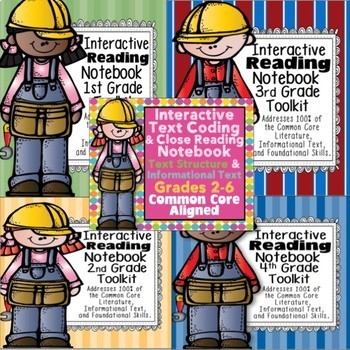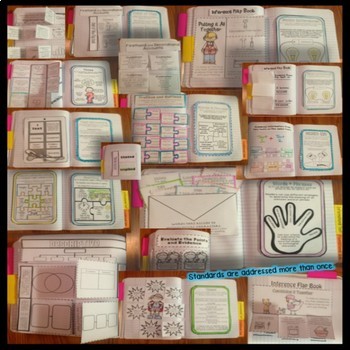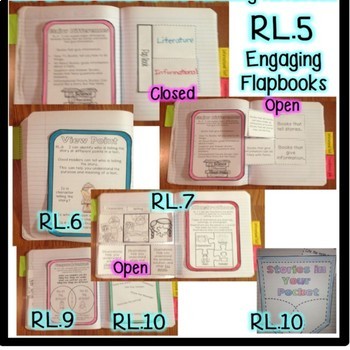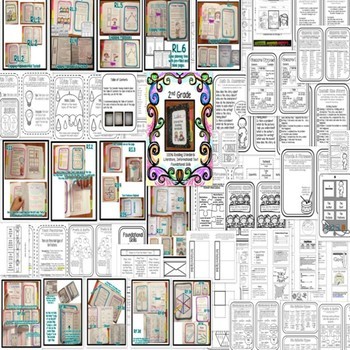Interactive Reading Notebooks 1st 2nd 3rd 4th grade Bundle Common Core Aligned
- Google Slides™
- Easel Activity

What educators are saying
Products in this Bundle (9)
showing 1-5 of 9 products
Description
100% Common Core Aligned this bundle of 5 of Top selling Interactive Notebooks with High ratings offered at a discounted price. Intended for teachers that find themselves teaching different grade levels or multipile grades throughout their career. The Interactive Text Coding & Close Reading Notebook is a huge bonus 2-6 grade for use with Close Reading materials which we off many Close Reading passages at our store.
Click here to see my Monthly Close Reading Units.
"Helping your children become text-dependent!"
Each monthly unit has history, biographies, science topics, holidays, and more!
Research each of these top seller Interactive notebooks or buy them individually. ALL Standards covered per grade level.
The comments are AMAZING!
Click here to see Common Core Close Reading Tools Aligned to Anchor Standards.
Click here to view Common Core Close Reading & Assessment Toolkit aligned to 1st.
Click here to view Common Core Close Reading & Assessment Toolkit aligned to 2nd.
Click here to view Common Core Close Reading & Assessment Toolkit aligned to 3rd.
Click here to view Common Core Close Reading & Assessment Toolkit aligned to 4th.
Also, Check out our Math Interactive Toolkit:
Click here to see my Interactive Math Toolkit. Recently updated!
The research behind "Interactive Notebooks" supports implementation in the classroom as it is proven that students will refer to the notebook as an anchor. The instructional practice by the teacher to support the promise to cover Common Core standards utilizing this researched based strategy proves fruitful for your students, parents and administrators. The benefits from implementing Interactive Notebooks in your classroom include a place for students to organize standards and the value student ownership of the tool. You, as the teacher, have a way to reach multiple intelligences by implementing a readers notebook in your classroom.
All standards for reading are addressed! The research behind "Interactive Notebooks" supports implementation in the classroom, as it is proven that students will refer to the notebook as an anchor. The instructional practice by the teacher to support and cover Common Core standards, by utilizing this researched based strategy, proves fruitful for your students, parents, and administrators. The benefits from implementing Interactive Notebooks in your classroom include a place for students to organize standards, and the value student ownership of the tool. You, as the teacher, have a way to reach multiple intelligences by implementing a readers notebook in your classroom.
Foldables and flap books can serve as standalone curriculum enhancers of common core. Templates are blank making it easy for you to integrate the numerous flipables in other content areas. :-)
Also included: Tabs, Dividers and Table of Contents for each strand.
A Message for You
Your satisfaction is my greatest desire and motivation. Rest assured that I will always stand and deliver to provide you a quality resource. Thank you for taking the time to look.
___________________________________________________________________
___________________________________________________________________
___________________________________________________________________
The tools presented in this notebook cover the following skills.
Literature
- RL.1.1 Asking and Answering Questions
- RL.1.2 Retell stories, including key details, and central message & lesson.
- RL.1.3 Describe characters, settings, and major events using key details.
- RL.1.4 Words and Phrases: that suggest feelings in stories and poems.
- RL.1.5 Explain major differences between books.
- RL.1.6 Identify who is telling the story.
- RL.1.7 Illustrations: To focus on the characters, setting, and events.
- RL.1.9 Compare and contrast: adventures and experiences of characters.
- RL.1.10 Anchor charts and tools to record first grade texts.
Informational Text
- RI.1.1 Ask and Answer Questions: About key details in a text.
- RI.1.2 Main Topic: Identify the main topic and retell key details.
- RI.1.3 Describe connections between individuals, events, ideas, or information.
- RI.1.4 Ask and answer questions to help clarify meaning of words and phrases.
- RI.1.5 Know and use text features to include electronic navigators.
- RI.1.6 Distinguish between information provided in pictures and text.
- RI.1.7 Illustrations and details describe the key ideas.
- RI.1.8 An author's reasons for the points in the text.
- RI.1.9 Identify similarities in and differences between two texts on the same topic.
- RI.1.10 Informational Text comprehension anchor.
Foundational Skills
- 6 Syllable Types: Anchor (Modeled after the chart in Appendix A of the CCSS)
- RF.1.1 Demonstrate understanding of basic features of print.
- RF.1.2a Distinguish long from short vowel sounds.
- RF.1.2b Single syllable words and consonant blends anchor charts.
- RF.1.2c Isolate and produce initial, medial and final vowel sounds anchor.
- RF.1.2d Segmenting words anchor/tool.
- RF.1.3a Common Digraphs charts/flip-ups.
- RF.1.3b Decode regularly spelled one syllable words.
- RF.1.3c Know final -e and common vowel team conventions for long vowels.
- RF.1.3d Syllable Claps Anchor
- RF.1.3e Decode words with 2 syllables.
- RF.1.3f Read words with inflectional endings -ed, -ing, -er, -est, -s, and 's.
- RF.1.3g Read irregularly spelled words.
- RF.1.4a Read with purpose and understanding anchor chart.
- RF.1.4b Read with fluency: Accuracy and expression
- RF.1.4c Use context to confirm or self-correct.
Literature
- RL.2.1 Asking and Answering Questions
- RL.2.2 Genres: Folktales and Fables with morals and lessons. * Retelling stories.
- RL.2.3 Describing characters w/ specifics for feelings and traits. Character change!
- RL.2.4 Words and Phrases: In rhythm, alliteration, rhyme and repetition.
- RL.2.5 Refer to story structure: focus b.m.e. beginning, middle, end
(Focus on Introduction and Conclusion)
- RL.2.6 Point of view and perspective (The View Point)
- RL.2.7 Illustrations: To focus on the characters, setting, and plot.
- RL.2.9 Compare and contrast: Looking at 2 stories by different authors from different cultures.
- RL.2.10 Comprehension tools to record fables, folktales, stories, and poems read in second grade.
Informational Text
- RI.2.1 Ask and Answer Questions: The author, the purpose, the features
- RI.2.2 Main Topic: Identify the main topic of multi paragraph texts as well as the specific focus of specific paragraphs within the text.
- RI.2.3 Focus on types of texts to include historical, scientific and technical
- RI.2.4 Words and phrases to include context clues, dictionary and strategies.
- RI.2.5 Text features to focus on three types of features such as navigators, types of print and visual features.
- RI.2.6 Identify the main purpose of a text and determine what the author wants to answer, explain or describe.
- RI.2.7 Images and Diagrams: can clarify and add meaning to the text.
- RI.2.8 Reasons for the points in the text.
- RI.2.9 Compare and contrast most important points and key details
- RI.2.10 Informational Text comprehension
Foundational Skills
6 Syllable Types: Anchor (Modeled after the chart in Appendix A of the CCSS)
- RF.2.3a Long and Short Vowel Sort with cards and envelope/ Anchor charts for short and long vowels
- RF.2.3b Vowel Teams: Common Vowel Teams
- RF.2.3c Multisyllable Words Note: Verbiage derived from Appendix A of the CCSS.
- RF.2.3d Prefixes and suffixes
- RF.2.3e Inconsistent but common spelling sound correspondences.
- RF.2.3f Irregular Words/ Irregularly spelled words
- RF.2.4a Purpose and understanding with a focus on text connections
- RF.2.4b Fluency Anchor Chart
- RF.2.4c Confirmation check
Literature
- RL.3.1 Asking and Answering Questions
- RL.3.2 Genres: Folktales, Fables, and Myths with morals and lessons. * Retelling and recounting stories.
- RL.3.3 Describing characters with specific differentiation for feelings and traits.
- RL.3.4 Using context clues. Literal and Non-literal foldables to focus on idioms
- RL.3.5 Refer to stories, dramas and poems
- RL.3.6 Point of view and perspective
- RL.3.7 Illustrations: To focus on the mood, setting, details and characters.
- RL.3.9 Compare and contrast also with specific focuses on theme and plot
- RL.3.10 Comprehension with tools to record literature.
Informational Text
- RI.3.1 Ask and Answer Questions to cite text evidence with text dependent questions.
- RI.3.2 Main Idea and details to focus on citing evidence to prove the main idea using details to include stated and implied main ideas also with factual and sensory details.
- RI.3.3 Focus on types of texts to include historical, scientific and technical
- RI.3.4 Words and phrases to include context clues, dictionary and strategies.
- RI.3.5 Text features to focus on three types of features such as navigators, types of print and visual features.
- RI.3.6 Point of view demonstrating differentiation between the author and the reader.
- RI.3.7 Illustrations to include photographs, maps and diagrams
- RI.3.8 Text Structure with focus on Compare & Contrast, Cause & Effect and Sequence.
- RI.3.9 Compare and contrast main points and key details
- RI.3.10 Informational Text comprehension
Foundational Skills
- RF.3.3a Common prefixes and suffixes
- RF.3.3b Latin suffixes Note: Verbiage is derived from Appendix A of the CCSS.
- RF.3.3c Multisyllable Words Note: Verbiage derived from Appendix A of the CCSS.
- RF.3.3d Irregular spelled words
- RF.3.4a Purpose and understanding with a focus on text connections
- RF.3.4b Fluency
- RF.3.4c Confirmation check
Literature
- RL.4.1 Making Inferences (Anchor Chart and Flap-book)
- RL.4.2 Themes (Anchor Chart and Flapbook) Summary (Checklist & Anchor Chart)
- RL.4.3 Characterization with specific differentiation for feelings and traits. Character, Setting, and Plot (5 notebook ready posters)
- RL.4.4 Using context clues anchor chart. Words and phrases anchor chart. 2 Idiom foldables and 1 envelope template with words and phrases that allude to mythological characters.
- RL.4.5 Refer to prose, dramas and poems (anchor chart and flip-ups for each prose, poem, & drama)
- RL.4.6 Point of view (anchor chart and foldable)
- RL.4.7 Text and drama visuals (3 anchor charts to differentiate text and drama)
- RL.4.9 Compare and contrast themes (2 anchor charts and 1 quest elements)
- RL.4.10 Synthesize anchor chart, monitor comprehension anchor chart, texts in your pocket interactive & ongoing collection act, and recording tools for prose, drama, and poems.
Informational Text
- RI.4.1 Make Inferences (Anchor Chart and Foldable)
- RI.4.2 Main Idea and details to focus on citing evidence to prove the main idea using details to include stated and implied main ideas also with factual and sensory details. (2 Anchor charts and 2 foldables)
- RI.4.3 Focus on types of texts to include historical, scientific and technical (1 anchor chart and 2 foldables)
- RI.4.4 Words and phrases to include context clues, dictionary and strategies. (1 anchor chart and 1 prefix and suffix informational text based puzzle paste)
- RI.4.5 Text structure: cause and effect, time/sequence/chronological order, comparison, problem and solution, and descriptive (2 anchor charts and flap books for each structure)
- RI.4.6 Point of view anchor chart demonstrating differentiation between firsthand and second hand- primary and secondary sources and flap books for each.
- RI.4.7 Interpretations anchor chart and informational text features flaps.
- RI.4.8 Author's Point anchor and reasons/points/evidence inserts.
- RI.4.9 Combine Information from 2 texts anchor and puzzle pastes.
- RI.4.10 Informational Text comprehension
Foundational Skills
- RF.4.3 Six syllable types anchor, word endings anchor, multi syllable words.
- RF.4.3a Latin suffixes Note: Verbiage is derived from Appendix A of the CCSS.
- RF.4.3 optional irregular spelling pattern
- RF.3.3d Irregular spelled words
- RF.4.4a Purpose and understanding with a focus on text connections
- RF.4.4b Fluency
- RF.4.4c Confirmation check
___________________________________________________________________
___________________________________________________________________
___________________________________________________________________
Other Common Core Products
Click here for my Common Core Close Reading Toolkit for 1st Grade.
Click here for my Common Core Close Reading Toolkit for 2nd Grade.
Click here for my Common Core Close Reading Toolkit for 3rd Grade.
___________________________________________________________________
___________________________________________________________________
Common Core units you may want to see.
Click here for a Common Core Math Practice Standard Toolkit.
Click here for a Text Dependent Question Cards/Stems/Frames.
___________________________________________________________________
___________________________________________________________________
Original works of
© 24/7 Teacher
Please ask any and all questions prior to purchasing!
Click here to ask 247 Teacher a question @ www.247teacher.us
___________________________________________________________________
For more on Text Coding, Text Structures, and Close Reading of Informational Texts.
Click here to see my Interactive Notebook for Informational Text, Text Structures, and Close Reads.
___________________________________________________________________
Click here to see my Monthly Close Reading Units.
"Helping your children become text-dependent!"
Each monthly unit has history, biographies, science topics, holidays, and more!
Designed for Close Reading: Other uses includehomework, social studies, or science.
Text dependent questions are designed for text evidence responses!
Each passage is written at FOUR levels. From first to fifth!
Each passage has five or more activities. Use for guided reading!
Each passage can be used as week-long homework!
Click here to check out my Monthly Close Reading Club!
January-December!
Click below to see each individual unit in the file.
Click below to see more of each individual unit in the file.
Click here for the January Close Reading Unit. 20 passages: EACH Written at FOUR levels.
Click here for the February Close Reading Unit. 20 passages: EACH Written at FOUR levels.
Click here for the March Close Reading Unit. 20 passages: EACH Written at FOUR levels.
Click here for the April Close Reading Unit. 20 passages: EACH Written at FOUR levels.
Click here for the May Close Reading Unit. 20 passages: EACH Written at FOUR levels.
Click here for the June Close Reading Unit. 20 passages: EACH Written at FOUR levels.
Click here for the August Close Reading Unit. 10 passages: EACH Written at FOUR levels.
Click here for the September Close Reading Unit. 20 passages: EACH Written at FOUR levels.
Click here for the October Close Reading Unit. 20 passages: EACH Written at FOUR levels.
Click here for the November Close Reading Unit. 20 passages: EACH Written at FOUR levels.
Click here for the December Close Reading Unit. 20 passages: EACH Written at FOUR levels.
Click the green links to see the titles included in each unit.
___________________________________________________________________
Click here to follow on FB for exclusive Facebook Only FREEBIES!
Click here to grab some new freebies at www.247teacher.us
Click here to follow on Pinterest!
___________________________________________________________________
All informational texts are original. Literature or fiction pieces are either original pieces written by Harrod or retellings by me from public domain. Original pieces are the copyrighted works of Joe Harrod, operating under the umbrella entity of 247 Teacher LLC.
If you have colleagues interested in my work, please respect the DMCA by directing them to my store. Your purchase is for one classroom only. Please purchase additional licenses if you intend to print for more than one classroom. If you have any questions please communicate with at jharrod@247teacher.us.
All rights reserved by 247 Teacher. This product may not be distributed digitally such as through any usb flash drive or mass storage device. Under no circumstance can this product be uploaded to any cyber sharing platform such as a server, drive, network, wiki, or digital cloud storage unless approved by 247 Teacher LLC. Failure to comply is a copyright infringement and a direct violation of the Digital Millennium Copyright Act (DMCA).
Thank you for recognizing my hard work and directing your colleagues to my store.





